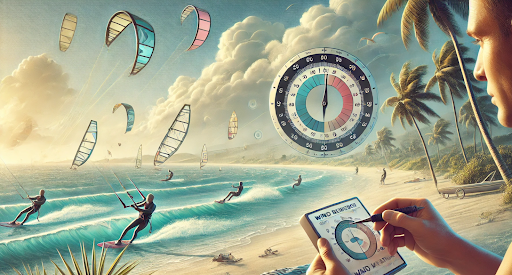
The Importance of Wind Knowledge in Water Sports
Wind is one of the most crucial elements in many water sports, especially those that rely on wind power for propulsion, such as kitesurfing, windsurfing, and sailing. Understanding the wind’s behavior and how it interacts with the water is essential for both performance and safety. For water sports enthusiasts, mastering wind knowledge can significantly improve your skills and help you make informed decisions while on the water. Here’s why wind knowledge is so important in water sports and how you can develop a better understanding of it.
- Wind Determines Performance
In wind-powered water sports like kitesurfing and sailing, wind speed and direction directly influence your performance. Wind is the force that propels you forward, and the strength and steadiness of the wind determine how fast and smoothly you can move across the water.
For example, in kitesurfing, too little wind can make it difficult to stay up on the board, while too much wind can make controlling the kite challenging. Understanding the wind allows you to choose the right gear and adjust your technique based on the conditions. Knowing how to read the wind’s strength and direction also helps you determine the best time to hit the water for optimal performance.
- Tip: For those looking to take advantage of consistent wind conditions, Riah Kite Academy offers a prime location with reliable thermal winds that are perfect for beginners and advanced riders alike.
- Safety Considerations
Wind knowledge is also critical for safety in water sports. Sudden changes in wind speed or direction can create dangerous conditions, especially if you’re far from shore or navigating busy waters. Knowing how to assess the wind’s behavior can help you avoid potentially hazardous situations.
Before heading out, it’s essential to check the weather forecast for wind conditions and look for signs of storms or strong gusts that could affect your time on the water. Understanding wind shadows—areas where the wind is blocked by an obstacle like a building or mountain—is also important, as these zones can cause sudden drops in wind power that may lead to loss of control.
By improving your wind knowledge, you’ll be better prepared to react to changes in the environment and make safe decisions while practicing your water sport of choice.
- Choosing the Right Equipment
One of the key benefits of understanding the wind is knowing how to select the right equipment for your session. In kitesurfing, windsurfing, and sailing, different wind strengths require different gear to optimize performance and safety. For example, in kitesurfing, lighter winds call for larger kites to generate enough power, while stronger winds necessitate smaller kites to maintain control.
Similarly, in windsurfing, the size of the sail must be adjusted based on wind strength to provide the right amount of propulsion without overpowering the rider. The more you understand about the wind, the more effectively you can choose the right equipment for the conditions.
- Wind Directions and Their Impact
Wind direction plays a significant role in water sports, affecting how you navigate and interact with the water. There are four primary wind directions to be aware of:
- Onshore Winds: These are winds that blow directly toward the shore. Onshore winds are generally safe for beginners because they push you back toward land. However, they can create choppy water conditions, which may make riding more challenging.
- Offshore Winds: These winds blow from the land out to sea. While they create smoother water conditions, offshore winds can be dangerous because they push riders away from the shore. It’s important to be cautious when riding in offshore winds and ensure you have the skills and equipment to return to land safely.
- Cross-shore Winds: Cross-shore winds blow parallel to the coastline and are often ideal for kitesurfing and windsurfing. They allow you to ride along the shore without being pushed too far out to sea or back to land.
- Cross-onshore and Cross-offshore Winds: These are variations of cross-shore winds that blow at an angle toward or away from the shore. Like cross-shore winds, they can offer good riding conditions, but it’s important to be aware of how they affect your ability to navigate.
Understanding how different wind directions affect the water and your riding technique can help you choose the best spot and approach for your session.
- Reading Local Wind Patterns
Wind patterns vary from one location to another, and being familiar with the local wind patterns of your favorite water sports destination can greatly enhance your experience. Many coastal areas, like El Gouna, experience thermal winds, which are generated by the temperature difference between the land and sea. These winds tend to be predictable and consistent, making them ideal for kitesurfing and windsurfing.
In other locations, wind conditions may be influenced by geographical features such as mountains, valleys, or nearby bodies of water. Learning about the specific wind patterns in your area and how they change throughout the day or season will allow you to plan your sessions more effectively and get the most out of your time on the water.
- Understanding Wind Forecasts
To make informed decisions about when and where to go kitesurfing, windsurfing, or sailing, it’s important to learn how to read wind forecasts. Wind forecasts provide crucial information about wind speed, direction, and potential changes in conditions over time.
Apps and websites like Windy, Windguru, and iKitesurf offer detailed wind forecasts that can help you plan your sessions. These tools provide real-time updates and allow you to monitor changes in wind conditions throughout the day. Understanding how to interpret these forecasts will help you choose the best time and location for your water sports activities.
- Tip: For those looking to learn more about wind patterns and how to apply that knowledge on the water, consider taking lessons with Wing Foil Lessons in Egypt, where you can develop your skills under the guidance of experienced instructors.
- Tides and Wind Interaction
While wind is the primary force in many water sports, it’s also important to understand how wind interacts with tides and currents. Tides can significantly affect the wind’s impact on the water, creating stronger or weaker conditions depending on the flow of the water. For example, an incoming tide may enhance the wind’s effect, while an outgoing tide may reduce it.
Understanding the interaction between wind and tides can help you make better decisions about when and where to ride, especially if you’re dealing with strong currents or fluctuating water levels.
Conclusion
Mastering wind knowledge is essential for anyone serious about water sports. By understanding wind speed, direction, and local patterns, you’ll be able to make smarter decisions about your gear, improve your performance, and stay safe on the water. Whether you’re a beginner or an experienced rider, investing time in learning about the wind will pay off with more enjoyable and successful sessions on the water.



